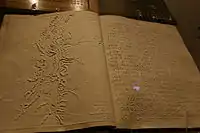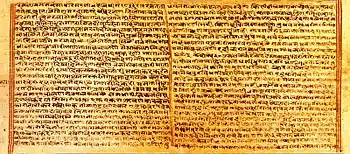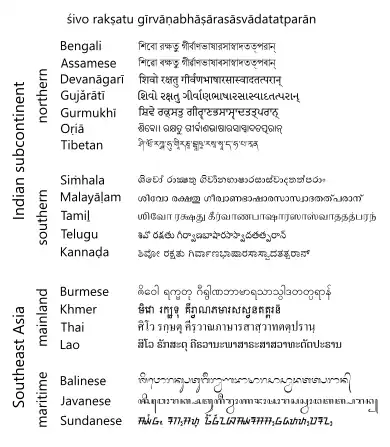
Introduction
.jpg.webp)



Language is a structured system of communication that consists of grammar and vocabulary. It is the primary means by which humans convey meaning, both in spoken and written forms, and may also be conveyed through sign languages. The vast majority of human languages have developed writing systems that allow for the recording and preservation of the sounds or signs of language. Human language is characterized by its cultural and historical diversity, with significant variations observed between cultures and across time. Human languages possess the properties of productivity and displacement, which enable the creation of an infinite number of sentences, and the ability to refer to objects, events, and ideas that are not immediately present in the discourse. The use of human language relies on social convention and is acquired through learning.
Estimates of the number of human languages in the world vary between 5,000 and 7,000. Precise estimates depend on an arbitrary distinction (dichotomy) established between languages and dialects. Natural languages are spoken, signed, or both; however, any language can be encoded into secondary media using auditory, visual, or tactile stimuli – for example, writing, whistling, signing, or braille. In other words, human language is modality-independent, but written or signed language is the way to inscribe or encode the natural human speech or gestures.
Depending on philosophical perspectives regarding the definition of language and meaning, when used as a general concept, "language" may refer to the cognitive ability to learn and use systems of complex communication, or to describe the set of rules that makes up these systems, or the set of utterances that can be produced from those rules. All languages rely on the process of semiosis to relate signs to particular meanings. Oral, manual and tactile languages contain a phonological system that governs how symbols are used to form sequences known as words or morphemes, and a syntactic system that governs how words and morphemes are combined to form phrases and utterances.
The scientific study of language is called linguistics. Critical examinations of languages, such as philosophy of language, the relationships between language and thought, how words represent experience, etc., have been debated at least since Gorgias and Plato in ancient Greek civilization. Thinkers such as Jean-Jacques Rousseau (1712–1778) have argued that language originated from emotions, while others like Immanuel Kant (1724–1804) have argued that languages originated from rational and logical thought. Twentieth century philosophers such as Ludwig Wittgenstein (1889–1951) argued that philosophy is really the study of language itself. Major figures in contemporary linguistics of these times include Ferdinand de Saussure and Noam Chomsky. (Full article...)
Selected language -
Yoruba (US: /ˈjɔːrəbə/ YOR-ə-bə, UK: /ˈjɒrʊbə/ YORR-uub-ə; Yor. Èdè Yorùbá, IPA: [jōrùbá]; Ajami: عِدعِ يوْرُبا) is a language spoken in West Africa, primarily in Southwestern and Central Nigeria. It is spoken by the ethnic Yoruba people. The number of Yoruba speakers is roughly 44 million, plus about 2 million second-language speakers. As a pluricentric language, it is primarily spoken in a dialectal area spanning Nigeria, Benin, and Togo with smaller migrated communities in Côte d'Ivoire, Sierra Leone and The Gambia.
Yoruba vocabulary is also used in the Afro-Brazilian religion known as Candomblé, in the Caribbean religion of Santería in the form of the liturgical Lucumí language and in various Afro-American religions of North America. Most modern practitioners of these religions in the Americas do not actually speak or understand the Yoruba language, rather they use Yoruba words and phrases for songs that for them are incomprehensible. Usage of a lexicon of Yoruba words and short phrases during ritual is also common, but they have gone through changes due to the fact that Yoruba is no longer a vernacular for them and fluency is not required. (Full article...)Did you know (auto-generated)
- ... that language creator Edgar de Wahl escaped deportation by the NKVD by being placed in a psychiatric hospital?
- ... that Ephraim E. Lisitzky wrote an epic poem in Hebrew based on Native American legends?
- ... that the software-testing framework pytest has been described as a key ecosystem project for the Python programming language?
- ... that Hirsch Sommerhausen worked as a court translator in a dozen languages?
- ... that Marja Kubašec was both the first Sorbian woman to receive a formal teacher training and the first woman to write a novel in Upper Sorbian?
- ... that after Los Angeles Spanish-language TV station KMEX-TV discovered that 15 percent of its viewers did not know the language, it added Spanish courses to its programming?
More did you know -

- ...that the totem pole (pictured) which welcomes visitors to the British Museum was documented for the museum by Rev. John Henry Keen years before it was purchased?
- ...that Missouri French is a nearly extinct dialect of French that developed in what is now the midwestern United States during the colonial period?
- ...that Hindi, Bengali, and Portuguese were all proposed as official languages of the United Nations?
- ...that the Vedda language is a Creole based on Sinhalese of Sri Lanka instead of a dialect?
Categories
Linguistics: Computational linguistics • Grammar • Historical linguistics • Morphology • Phonetics • Phonology • Pragmatics • Reading • Semantics • Sociolinguistics • Syntax • Writing
Languages: Language families • Pidgins and creoles • Sign languages
Linguists: By nationality • Historical linguists • Morphologists • Phoneticians • Phonologists • Sociolinguists • Syntacticians • Translators
Stubs: Constructed languages • Languages • Linguists • Pidgins and creoles • Typography • Vocabulary and usage • Writing systems
Full Language category tree |
|---|
|
Select [►] to view subcategories
Language Languages Outlines of languages Language acquisition Language-related awards Language comparison Language competitions Natural language and computing Language in fiction Language games Gender in language Language identifiers Language interpretation Language movements Language preservation Language reform Linguistics Language mechanics Language and mysticism Oral communication Philology Philosophy of language Language policy Self-reference Sign language Sociology of language Language software Speech Speech and language pathology Statements Terminology Vocabulary Works about language Writing Language stubs |
Related portals
Selected topic -
Latin obscenity is the profane, indecent, or impolite vocabulary of Latin, and its uses. Words deemed obscene were described as obsc(a)ena (obscene, lewd, unfit for public use), or improba (improper, in poor taste, undignified). Documented obscenities occurred rarely in classical Latin literature, limited to certain types of writing such as epigrams, but they are commonly used in the graffiti written on the walls of Pompeii and Herculaneum. Among the documents of interest in this area is a letter written by Cicero in 45 BC (ad Fam. 9.22) to a friend called Paetus, in which he alludes to a number of obscene words without actually naming them.
Apart from graffiti, the writers who used obscene words most were Catullus and Martial in their shorter poems. Another source is the anonymous Priapeia (see External links below), a collection of 95 epigrams supposedly written to adorn statues of the fertility god Priapus, whose wooden image was customarily set up to protect orchards against thieves. The earlier poems of Horace also contained some obscenities. However, the satirists Persius and Juvenal, although often describing obscene acts, did so without mentioning the obscene words. Medical, especially veterinary, texts also use certain anatomical words that, outside of their technical context, might have been considered obscene. (Full article...)Selected picture -

Maryada Patral letter of conduct written by Acharya Bhiksu (first head of Jain Swetamber Terapanth sect) written in Rajasthani language
Language News
- 26 July 2023 – 2023 Malian constitutional referendum
- Mali downgrades the French language from official language to working language in accordance with the new constitution. (Africanews)
Topics
Languages of Africa: Arabic, Chadic, Cushitic, Kanuri, Maasai, Setswana, Swahili, Turkana, Xhosa, Yoruba, Zulu, more...
Languages of the Americas: Aleut, Carib, Cherokee, Inuktitut, Iroquois, Kootenai, Mayan, Nahuatl, Navajo, Quechuan, Salish, American Sign Language, more...
Languages of Asia: Arabic, Assamese, Balochi, Bengali, Chinese, Japanese, Hajong, Hebrew, Hindustani, Kannada, Kokborok, Marathi, Khasi, Korean, Kurdish, Malayalam, Manipuri, Meithei, Mongolian, Persian, Rajasthani, Sindhi, Sanskrit, Sylheti, Tamil, Tanchangya, Tulu, Telugu, Tibetan, Thai, Turkish, Vietnamese, Khowar, more...
Languages of Austronesia: Austric, Fijian, Hawaiian, Javanese, Malagasy, Malay, Maori, Marshallese, Samoan, Tahitian, Tagalog, Tongan, Auslan, more...
Languages of Europe: Basque, Czech, Danish, Dutch, English (book), French, German, Greek, Italian, Latin, Leonese, Norwegian, Polish, Portuguese, Romanian, Russian, Slovak, Spanish, Ukrainian more...
Constructed languages: Esperanto, Ido, Volapük, more...
Agglutinative language, Analytic language, Constructed language, Creole, Context-free language, Extinct language, Dialect, Fusional language, Inflectional language, International language, Isolating language, Language isolate, National language, Natural language, Pidgin, Pluricentric language, Polysynthetic language, Proto-language, Sign language, Spoken language, Synthetic language, Variety (linguistics)

Applied linguistics, Cognitive linguistics, Accent (dialect), Computational linguistics, Descriptive linguistics, Eurolinguistics, Generative linguistics, Historical linguistics, Lexicology, Lexical semantics, Morphology, Onomasiology, Phonetics, Phonology, Pragmatics, Prescription, Prototype semantics, Psycholinguistics, Semantics, Stylistics, Sociolinguistics, Syntax
See also: List of linguists

Alphabets: Arabic alphabet, Bengali alphabet, Cyrillic alphabet, Hebrew alphabet, Latin alphabet, more...
Other writing systems: Abjad, Abugida, Braille, Hieroglyphics, Logogram, Syllabary, SignWriting, more..
See also: History of the alphabet, Script
Associated Wikimedia
The following Wikimedia Foundation sister projects provide more on this subject:
-
 Commons
Commons
Free media repository -
 Wikibooks
Wikibooks
Free textbooks and manuals -
 Wikidata
Wikidata
Free knowledge base -
 Wikinews
Wikinews
Free-content news -
 Wikiquote
Wikiquote
Collection of quotations -
 Wikisource
Wikisource
Free-content library -
 Wikiversity
Wikiversity
Free learning tools -
 Wiktionary
Wiktionary
Dictionary and thesaurus
Find a language
| Enter an ISO 639 code to find the corresponding language article |
-
 List of all portalsList of all portals
List of all portalsList of all portals -
 The arts portal
The arts portal -
 Biography portal
Biography portal -
 Current events portal
Current events portal -
 Geography portal
Geography portal -
 History portal
History portal -
 Mathematics portal
Mathematics portal -
 Science portal
Science portal -
 Society portal
Society portal -
 Technology portal
Technology portal -
 Random portalRandom portal
Random portalRandom portal -
 WikiProject PortalsWikiProject Portals
WikiProject PortalsWikiProject Portals